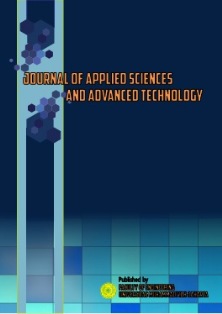The Gel Strength and Profile Texture of Liquid Crude Extract from Fish Bone Gelatin by Pineapple Waste Combined Water Extraction
DOI:
https://doi.org/10.24853/jasat.1.1.9-14Keywords:
Fish bone Gelatin Gel strength Profile texture Crude extractAbstract
The gel strength and profile texture was the most important physical characteristic of gelatin. Unfortunately, the gelatin based on alternative source such as bone of fish has low gel strength and profile texture value compared mammalian gelatin. In another side, the extraction gelatin method has been using more saver solvent such as citric acid and water. The aim of this research was extracted gelatin from bone of fish using pineapple waste and water. Then continued with the gel strength and profile texture analysis of gelatin crude extract. The result shown that the fish bone gelatin successful extracted using pineapple waste combined with warm water at pre-treatment and main extraction respectively. The gel strength of fish bone gelatin was 430 g.bloom. Profile texture of crude extract fish bone gelatin including hardness was 9.83 N, cohesiveness of 0.46, springiness of 2.91, gumminess of 4.52 N and chewiness of 14.30. The result suggested that liquid crude extract of fish bone gelatin was comparable toward mammalian and another fish gelatinDownloads
References
A.A. Karim, R. Bhat, Food Hydrocoll 23 (2009) 563.
I. Ratnasari, S.S Yuwono, H. Nusyam, and S.B. Widjanarko, Int Food Res J 20 (2013) 3085.
J.M. Koli, S. Basu, B.B. Nayak, S.B. Patange, A.U. Pagarkar, and V. Gudipati, Food Bioprod Process 90 (2012 ) 555.
R. Widyasari, S. Rawdkuen, Food Appl Biosci J 2 (2014) 85.
A.A. Mariod, S.I Abdel-Wahab, M.Y Ibrahim, S. Mohan, M. Abd Elgadir, and N.M Ain, J. Food Sci. Eng 1 (2011), 45.
J. Wasswa, J. Tang, and X. Gu. Food Rev Int 23 (2007) 159.
F. Mahmoodani, A.V. Sanaei, S.F. See, S.M. Yusop, and A.S. Babji, J. Food Sci Technol 51 (2014) 3104.
N. Somboon, T.T. Karrila, T. Kaewmanee, and S.J. Karrila, Int Food Res J 21 (2014) 485.
C.K Wu, J.S Tsai and W.C Sung, Int J Food Prop 18 (2015) 1702.
R. Bhat, A.A. Karim, Food Chem 113 (2009) 1160.
Y Atma, IOP Conf. Ser.: Earth Environ. Sci. 58 (2017) 012008.
R.H. Saputra, I. Widiastuti, and A. Supriadi, Jurnal Teknologi Hasil Perikanan 4 (2015) 29.
A.A. Mariod, H.F Adam, Acta Sci. Pol., Technol. Aliment. 12 (2013) 135.
D. Fatimah, A. Jannah, Alchemy 1 (2008): 7.
F. Badii, N.K. Howell, Food Hydrocoll 20 (2006) 630.
Y. Adiningsih, T. Purwanti, Jurnal Riset Teknologi Industri 9 (2015) 149.
A.V. Sanaei, F. Mahmoodani, S.F. See, S.M. Yusop, A.S. Babji. Int Food Res J 20 (2013) 423.
M. Iqbal, C. Anam, A. Ridwan. Jurnal Teknosains Pangan 4 (2015) 8.
C. Santoso, T. Surti, Sumardianto, Jurnal Pengolahan & Bioteknologi Hasil Perikanan 4 (2015) 106.
Syahraeni, M. Anwar, Hasri, Analytical Environmental Chemistry 2 (2017) 53.
Y. Wang, J.M Regenstein, J. Food Sci 74 (2009) 426.
A. Upadhyay, J.P. Lama, and S.Tawata, J. Food Sci. Technol. Nepal 6 (2010) 10.
GME, Standard Methods for the Testing of Edible Gelatine, Gelatine Monograph, Gelatin Manufacturers of Europe (2005).
GMIA, Gelatin Handbook (2012).
A. da Trindade Alfaro, C. Simoes da Costa, G Fonseca G, and C. Prentice, Food Sci Tech Int. 15 (2009) 553.
Muyoga J H, Cole C G B and Duodu K G 2004 Food Chem 85 81.
R. Kamble, S.T. Shrangdher, and J.M Koli, Indian Journal of Fundamental and Applied Life Sciences 4 (2014) 328
Downloads
Published
Issue
Section
License
COPYRIGHT POLICY
The author(s) of an article published in the Journal of Applied Sciences and Advanced Technology (JASAT) retains ownership of the intellectual property rights in work (s).
PUBLISHING RIGHTS
The author(s) of an article published in the Journal of Applied Sciences and Advanced Technology (JASAT) have unrestricted publication rights. The authors give the Journal of Applied Sciences and Advanced Technology (JASAT) the right to publish the article and designate the Faculty of Engineering Universitas Muhammadiyah Jakarta Publishing as the original publisher of the article.
LICENSING POLICY
JASAT is an open-access journal that follows the Creative Commons Non-Commercial 4.0 International License (CC BY-NC 4.0), which states that:

Under this license, the reusers must give appropriate credit, provide a link to the license, and indicate if changes were made. Users may do so in any reasonable manner, but not in any way that suggests the licensor endorses users or their use.
Please take the time to read the whole license agreement (https://creativecommons.org/licenses/by-nc/4.0/). As long as reusers follow the license conditions, the owner cannot withdraw these freedoms. The following components are included under this license:
 Attribution: Users must provide appropriate attribution, including a link to the license, and indicate whether or not they made any modifications. Users are free to do so reasonably, but not in a manner that indicates the licensee approves of their usage.
Attribution: Users must provide appropriate attribution, including a link to the license, and indicate whether or not they made any modifications. Users are free to do so reasonably, but not in a manner that indicates the licensee approves of their usage.
 NonCommercial: Users may not use the material for commercial purposes.
NonCommercial: Users may not use the material for commercial purposes.












_2.png)


1.png)

2.png)
